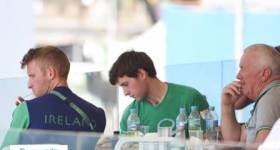Displaying items by tag: Coach of the Year
Dominic Casey is the World Rowing Coach of the Year
#Rowing: Dominic Casey has been chosen as the World Rowing Coach of the Year. The Skibbereen man, who coached Paul and Gary O’Donovan to a World Championship gold medal this year, received the award at a gala in Berlin. He had also been nominated in 2016 and 2017. In these years he oversaw the first Olympic medal for Ireland rowing, when the O’Donovan brothers took silver in Rio de Janeiro, and a string of gold medals for Mark O’Donovan and Shane O’Driscoll in the lightweight pair. In 2017, lightweight single sculler Denise Walsh also took silver in the European Championships and a World Cup silver.
Other awards on a glittering night went to the Australian men’s four, who were named the male crew of the year ahead of Paul and Gary O’Donovan, and the Poland quadruple, who took the women’s crew of the year, an award for which Sanita Puspure was nominated.
The 2018 World Rowing Para Crew of the Year is the Dutch PR2 mixed double of Annika van der Meer and Corne de Koning. The Sri Lankan oarsman and university student, Amidu Silva, won the 2018 Filippi Spirit Award.
The World Rowing Sustainability Award was taken by Alan Robinson and Schuylkill Navy for Love Where you Row.
The 2018 Distinguished Service to International Rowing award was won by Borge Kaas Andersen of Denmark.
Dominic Casey a Finalist for World Rowing Coach of the Year
#Rowing: Dominic Casey has been named as a finalist for the coach of the year in the World Rowing Awards for 2016. The Corkman guided the Ireland lightweight double of Paul and Gary O’Donovan to a silver medal at the Olympic Games. The crew also won gold at the European Championships and silver at the World Cup in Varese in Italy. Paul O’Donovan, also coached by Casey, won gold in the lightweight single sculls at the World Rowing Championships. The Olympic gold medallists in the lightweight double, Pierre Houin and Jeremie Azou of France, have made the final for Male Crew of the Year. The council of Fisa, the sport’s governing body, picked the finalists after a public nomination process which began on October 9th. The winners will be announced on December 2nd.
























